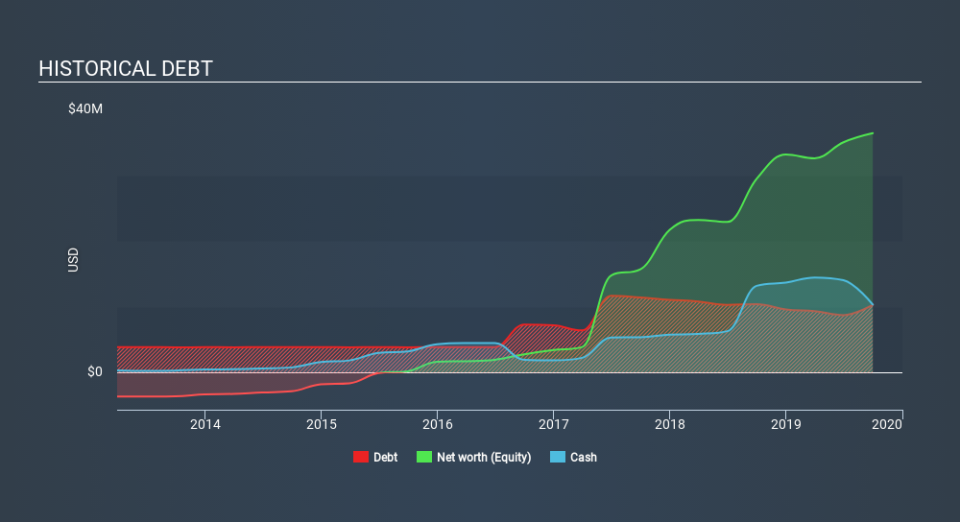These 4 Measures Indicate That Hamilton Thorne (CVE:HTL) Is Using Debt Reasonably Well

Some say volatility, rather than debt, is the best way to think about risk as an investor, but Warren Buffett famously said that 'Volatility is far from synonymous with risk'. When we think about how risky a company is, we always like to look at its use of debt, since debt overload can lead to ruin. As with many other companies Hamilton Thorne Ltd. (CVE:HTL) makes use of debt. But is this debt a concern to shareholders?
When Is Debt A Problem?
Generally speaking, debt only becomes a real problem when a company can't easily pay it off, either by raising capital or with its own cash flow. If things get really bad, the lenders can take control of the business. However, a more frequent (but still costly) occurrence is where a company must issue shares at bargain-basement prices, permanently diluting shareholders, just to shore up its balance sheet. By replacing dilution, though, debt can be an extremely good tool for businesses that need capital to invest in growth at high rates of return. The first step when considering a company's debt levels is to consider its cash and debt together.
View our latest analysis for Hamilton Thorne
What Is Hamilton Thorne's Debt?
The chart below, which you can click on for greater detail, shows that Hamilton Thorne had US$10.3m in debt in September 2019; about the same as the year before. But on the other hand it also has US$10.3m in cash, leading to a US$32.5k net cash position.
How Strong Is Hamilton Thorne's Balance Sheet?
According to the last reported balance sheet, Hamilton Thorne had liabilities of US$10.6m due within 12 months, and liabilities of US$8.44m due beyond 12 months. Offsetting these obligations, it had cash of US$10.3m as well as receivables valued at US$4.26m due within 12 months. So its liabilities outweigh the sum of its cash and (near-term) receivables by US$4.40m.
Of course, Hamilton Thorne has a market capitalization of US$113.6m, so these liabilities are probably manageable. But there are sufficient liabilities that we would certainly recommend shareholders continue to monitor the balance sheet, going forward. While it does have liabilities worth noting, Hamilton Thorne also has more cash than debt, so we're pretty confident it can manage its debt safely.
Hamilton Thorne grew its EBIT by 4.7% in the last year. That's far from incredible but it is a good thing, when it comes to paying off debt. The balance sheet is clearly the area to focus on when you are analysing debt. But ultimately the future profitability of the business will decide if Hamilton Thorne can strengthen its balance sheet over time. So if you want to see what the professionals think, you might find this free report on analyst profit forecasts to be interesting.
Finally, a business needs free cash flow to pay off debt; accounting profits just don't cut it. While Hamilton Thorne has net cash on its balance sheet, it's still worth taking a look at its ability to convert earnings before interest and tax (EBIT) to free cash flow, to help us understand how quickly it is building (or eroding) that cash balance. Over the most recent three years, Hamilton Thorne recorded free cash flow worth 69% of its EBIT, which is around normal, given free cash flow excludes interest and tax. This free cash flow puts the company in a good position to pay down debt, when appropriate.
Summing up
While it is always sensible to look at a company's total liabilities, it is very reassuring that Hamilton Thorne has US$32.5k in net cash. The cherry on top was that in converted 69% of that EBIT to free cash flow, bringing in US$3.3m. So we don't have any problem with Hamilton Thorne's use of debt. When analysing debt levels, the balance sheet is the obvious place to start. But ultimately, every company can contain risks that exist outside of the balance sheet. For instance, we've identified 4 warning signs for Hamilton Thorne that you should be aware of.
At the end of the day, it's often better to focus on companies that are free from net debt. You can access our special list of such companies (all with a track record of profit growth). It's free.
If you spot an error that warrants correction, please contact the editor at editorial-team@simplywallst.com. This article by Simply Wall St is general in nature. It does not constitute a recommendation to buy or sell any stock, and does not take account of your objectives, or your financial situation. Simply Wall St has no position in the stocks mentioned.
We aim to bring you long-term focused research analysis driven by fundamental data. Note that our analysis may not factor in the latest price-sensitive company announcements or qualitative material. Thank you for reading.

 Yahoo Finance
Yahoo Finance 
